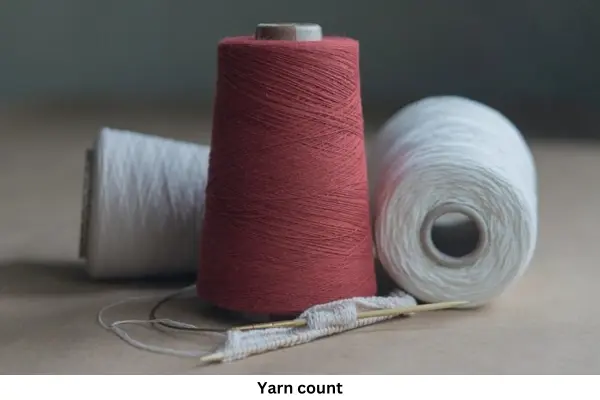To explain the quality of a textile fabric we must first refer to the count and construction of the fabric. Here, count means the yarn count and by construction means the number of warp yarns and weft yarns used in one inch of fabric.
Count is a numerical term that indicates the fineness or coarseness of the yarn. In other words, the mass per unit length of yarn or the length per unit mass is called count. In the textile industry, the count is used to express how fine or coarse the yarn is.
Table of Contents
Types of Yarn Count
We already have an idea of what the count is. Yarn count can be measured by various methods. Among them, two methods are mainly used. One is the Indirect system and the other is the Direct system.
The above two types of yarn count are explained in the below:
Indirect System
In an indirect system, Count is measured as the length of yarn in one unit weight. The general feature of all indirect count systems is the weight of the yarn fixed, and the length of the yarn varies according to its fineness. Thus higher the count, the finer the yarn. The system is generally used for cotton, worsted, linen (wet spun), etc.
For the Indirect system Used formula,
N = (L × w) / ( l × W)
Where,
N = count
L = length of yarn
l = unit of length
W = weight of yarn
w = unit of weight
Some Indirect count systems are described below-
1.English Cotton Count(Ne): The English cotton count is also pertain to as Number English or Ne and it’s an indirect system of determining the size of a specific cotton yarn. In English cotton count system, yarn count is measured by calculating the total number of hanks of 840 yards present in one pound weight of yarn.
For example, 50 Ne count means that there are 50 hanks ( one hank = 840 yards length of yarn) present in 1 lb or 1 pound weight of yarn . In other words, if the count of yarn is 50 Ne , it means that 50 hanks (of 840 yards) of that yarn will weight 1 pound.
The following formula is used to calculate yarn count in an indirect system :
English Count (Ne)= Length(yds) × 1 pound / 840 yds × weight(pound)
2. Metric Yarn Count(Nm) : Metric yarn count is specified by the total number of hanks of 1000 meter yarn present in 1 kilogram weight of yarn. So, It indicates how many hanks of 1000 meters can be obtained from 1000 gram or 1 kilogram weight of yarn. This system refers to the numerical expression that indicates how defined or coarse a yarn is. The yarn becomes finer when metric count increases. It is usually used to indicate the count of cotton yarn as well as flax yarn. Metric count of yarn is calculated by given below method:
Metric Count = Length(m) × 1 kg / 1000 m × Weight(kg)
3. Worsted Count (NeK): Worsted count is an indirect indication of the fineness of the fiber in a worsted wool yarn described as the number of 560-yard length hanks of worsted yarn present in 1 pound of the yarn. It is broadly used for yarn constituted by wool. For higher count, the fineness of the yarn is more.
Example, If (10×560) yards length of yarn is one pound then its count is 10. The formula of worsted count are given below :
Worsted count = (Length in yards) / (560 x weight in pound)

Direct System
In direct system, the count is constructed on the number of weight units in a length unit.This system is mainly used to measure the count for artificial fiber.The general feature of the direct count method is that the length of the yarn is fixed and the weight of the yarn varies according to its fineness. Direct count is used for very fine and very coarse yarns. This system is mostly used in the case of yarns like silk, jute etc. For Direct system Used formula,
N = (W × l) / (w × L)
Where,
N = count
L = length of yarn
l = unit of length
W = weight of yarn
w = unit of weight
Some Direct count system are described below-
1.Tex: Tex gives the weight in grams per 1000 meters of yarn. It can be described as the weight in 1000 meters of yarn in grams where length of yarn is fixed. For example, if there is 10 grams of yarn per 1000 meters of yarn, that indicates 10 tex. The following formula is used to calculate Tex count in direct system :
Tex count = (Weight gm×1000 m) / (1 gm×Length m)
2.Denier: Denier is another direct measure of linear density. Weight in grams per 9000 m of yarn is called denier. It is mainly used for man-made yarns.
For example, yarn count 10 Denier means that there are 10 gm of yarn per 9000 m of that yarn.
In this system, lower the count, finer the yarn. For example, 20 denier yarn is much finer than a 50 denier yarn.
The following formula is used to calculate Denier count in direct system :
Denier count = (Weight gm × 9000 m) / (1gm × Length m)
3.Pound per spyndle / jute count : Jute count is known as weight in pounds per one spindle of 14400 yards. This system is commonly used in the case of jute,hemp or dry spun-linen yarn.
For example, yarn count 10 Pounds per Spyndle means that 14400 m of that yarn will weigh 10 lbs.
The following formula is used to calculate Jute count in direct system :
Pound per spindle or Jute count = (Weight pound × 14000 yds) / (1 pound × Length yds)
4. Decitex (dtex) : Weight in grams of 10000 meters of yarn is called Decitex, which is a metric unit used to determine the linear density or fineness of yarns. It’s mainly used for continuous filament yarn.
For example, 10 dtex means 10 g per 10,000 m yarn.
The following formula is used to calculate Decitex in direct system :
Decitex(dtex) = (10000 × weight in grams) / (Length in meters)
5. MiliTex (mTex):In the miliTex system, count is the weight in milligrams of 1000 m of yarn.
For instance, yarn count 10 milliTex means that there are 10 milligrams of yarn per 1000 m of that yarn.
The following formula is used to calculate Milliitex in direct system :
Millitex(mtex) = (1000 × weight in milligrams) / (length in meters)
6. Kilotex (ktex): In the kilotex system, count is the weight in kilograms of 1000 m of yarn.
For example, 20 kilotex means 1000 meters of length in 20 kilograms of weight.
The following formula is used to calculate kilotex in direct system :
Kilotex(ktex) = (1000 × weight in kilograms) / (length in meters)
Conclusion
Yarn count is a very important subject in textile engineering. But even those with the highest degrees in textiles are often seen having trouble with counts. One of the main reasons for this is that the language of the textbooks that we try to learn about counts does not enter our heads in a mature way. Instead of focusing on traditional textbooks, if we consider only one subject by criteria, then the matter becomes much simpler. So taking everything into consideration, the above article is written in simple language, hope everyone benefited.


